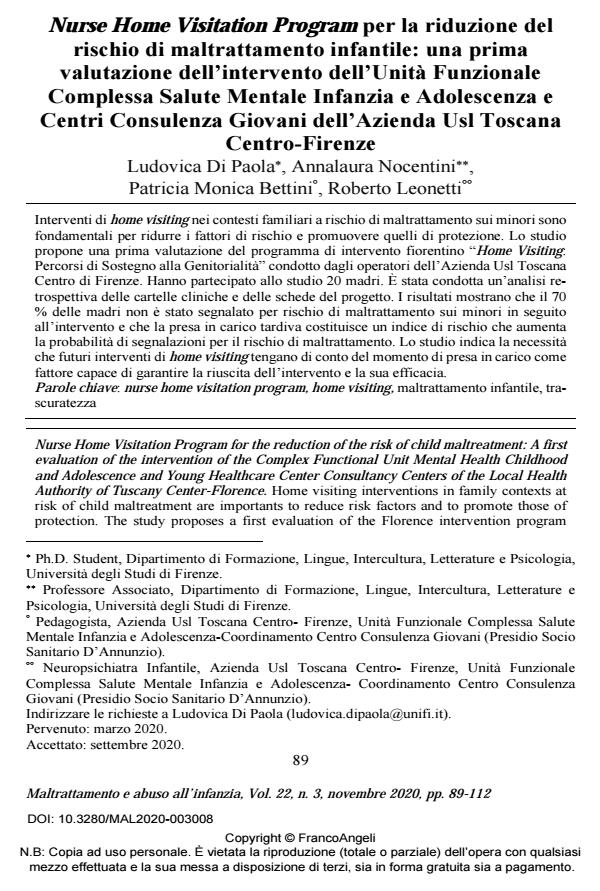Nurse Home Visitation Program for the reduction of the risk of child maltreatment: A first evaluation of the intervention of the Complex Functional Unit Mental Health Childhood and Adolescence and Young Healthcare Center Consultancy Centers of the Local Health Authority of Tuscany Center-Florence.
Journal title MALTRATTAMENTO E ABUSO ALL’INFANZIA
Author/s Ludovica Di Paola, Annalaura Nocentini, Patricia Monica Bettini, Roberto Leonetti
Publishing Year 2021 Issue 2020/3
Language Italian Pages 24 P. 89-112 File size 297 KB
DOI 10.3280/MAL2020-003008
DOI is like a bar code for intellectual property: to have more infomation
click here
Below, you can see the article first page
If you want to buy this article in PDF format, you can do it, following the instructions to buy download credits

FrancoAngeli is member of Publishers International Linking Association, Inc (PILA), a not-for-profit association which run the CrossRef service enabling links to and from online scholarly content.
Home visiting interventions in family contexts at risk of child maltreatment are importants to reduce risk factors and to promote those of pro-tection. The study proposes a first evaluation of the Florence intervention program "Home Visiting: Percorsi di Sostegno alla Genitorialità" conducted by the health workers of the Local Health Authority Tuscany Center of Florence. The study involved 20 mothers. It was conducted a retrospective analysis of the medical records and of the project files. The re-sults show that 70% of mothers have not been reported due to the risk of child maltreatment following the intervention and that late taking-charge of mothers is a risk that increases the probability of incurring reports of the risk of maltreatment. The study indicates the need for future home visiting interventions to take into account the moment of taking charge as a factor capable of guaranteeing the success of the intervention and its effectiveness.
Keywords: Nurse home visitation program, home visiting, child abuse, neglect.
- Making rights real in children's lives Agata D’Addato, in MALTRATTAMENTO E ABUSO ALL'INFANZIA 1/2023 pp.11
DOI: 10.3280/MAL2023-001002 - Il progetto PEARLS for children in Italia, in Lituania e in Polonia Maura Brandoni, in MALTRATTAMENTO E ABUSO ALL'INFANZIA 1/2023 pp.19
DOI: 10.3280/MAL2023-001003 - TimMi: Ambulatorio per l'intercettazione delle fragilità familiari e la prevenzione del maltrattamento all'infanzia Lucia Romeo, Giusy Soldato, Valeria Brazzoduro, Monica Patrizio, Federica Giannotta, in MALTRATTAMENTO E ABUSO ALL'INFANZIA 1/2021 pp.89
DOI: 10.3280/MAL2021-001006
Ludovica Di Paola, Annalaura Nocentini, Patricia Monica Bettini, Roberto Leonetti, Nurse Home Visitation Program per la riduzione del rischio di maltrattamento infantile: una prima valutazione dell’intervento dell’Unità Funzionale Complessa Salute Mentale Infanzia e Adolescenza e Centri Consulenza Giovani dell’Azienda Usl Toscana Centro-Firenze in "MALTRATTAMENTO E ABUSO ALL’INFANZIA" 3/2020, pp 89-112, DOI: 10.3280/MAL2020-003008